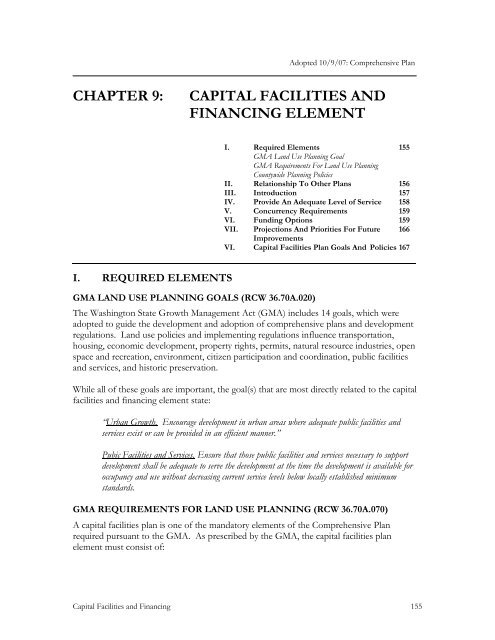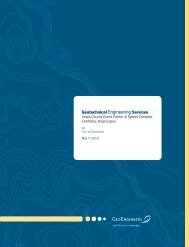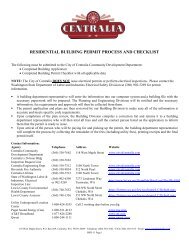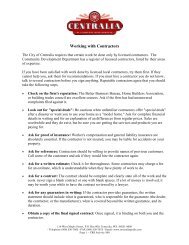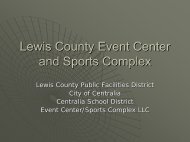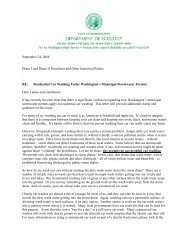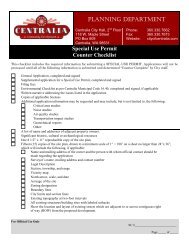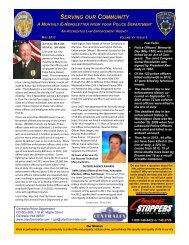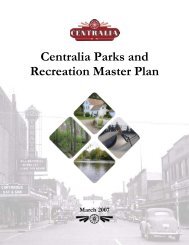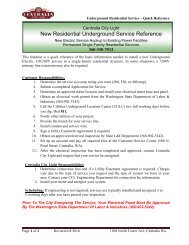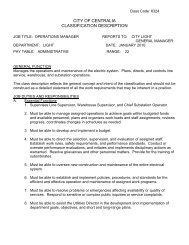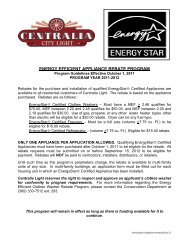capital facilities and financing element - City of Centralia, WA
capital facilities and financing element - City of Centralia, WA
capital facilities and financing element - City of Centralia, WA
You also want an ePaper? Increase the reach of your titles
YUMPU automatically turns print PDFs into web optimized ePapers that Google loves.
Adopted 10/9/07: Comprehensive Plan<br />
CHAPTER 9:<br />
CAPITAL FACILITIES AND<br />
FINANCING ELEMENT<br />
I. Required Elements 155<br />
GMA L<strong>and</strong> Use Planning Goal<br />
GMA Requirements For L<strong>and</strong> Use Planning<br />
Countywide Planning Policies<br />
II. Relationship To Other Plans 156<br />
III. Introduction 157<br />
IV. Provide An Adequate Level <strong>of</strong> Service 158<br />
V. Concurrency Requirements 159<br />
VI. Funding Options 159<br />
VII. Projections And Priorities For Future 166<br />
Improvements<br />
VI. Capital Facilities Plan Goals And Policies 167<br />
I. REQUIRED ELEMENTS<br />
GMA LAND USE PLANNING GOALS (RCW 36.70A.020)<br />
The Washington State Growth Management Act (GMA) includes 14 goals, which were<br />
adopted to guide the development <strong>and</strong> adoption <strong>of</strong> comprehensive plans <strong>and</strong> development<br />
regulations. L<strong>and</strong> use policies <strong>and</strong> implementing regulations influence transportation,<br />
housing, economic development, property rights, permits, natural resource industries, open<br />
space <strong>and</strong> recreation, environment, citizen participation <strong>and</strong> coordination, public <strong>facilities</strong><br />
<strong>and</strong> services, <strong>and</strong> historic preservation.<br />
While all <strong>of</strong> these goals are important, the goal(s) that are most directly related to the <strong>capital</strong><br />
<strong>facilities</strong> <strong>and</strong> <strong>financing</strong> <strong>element</strong> state:<br />
“Urban Growth. Encourage development in urban areas where adequate public <strong>facilities</strong> <strong>and</strong><br />
services exist or can be provided in an efficient manner.”<br />
Pubic Facilities <strong>and</strong> Services. Ensure that those public <strong>facilities</strong> <strong>and</strong> services necessary to support<br />
development shall be adequate to serve the development at the time the development is available for<br />
occupancy <strong>and</strong> use without decreasing current service levels below locally established minimum<br />
st<strong>and</strong>ards.<br />
GMA REQUIREMENTS FOR LAND USE PLANNING (RCW 36.70A.070)<br />
A <strong>capital</strong> <strong>facilities</strong> plan is one <strong>of</strong> the m<strong>and</strong>atory <strong>element</strong>s <strong>of</strong> the Comprehensive Plan<br />
required pursuant to the GMA. As prescribed by the GMA, the <strong>capital</strong> <strong>facilities</strong> plan<br />
<strong>element</strong> must consist <strong>of</strong>:<br />
Capital Facilities <strong>and</strong> Financing 155
Adopted 10/9/07: Comprehensive Plan<br />
(a)<br />
(b)<br />
(c)<br />
(d)<br />
(e)<br />
An inventory <strong>of</strong> existing <strong>capital</strong> <strong>facilities</strong> owned by public entities, showing the<br />
locations <strong>and</strong> capacities <strong>of</strong> the <strong>capital</strong> <strong>facilities</strong>;<br />
A forecast <strong>of</strong> the future needs for such <strong>capital</strong> <strong>facilities</strong>;<br />
The proposed locations <strong>and</strong> capacities <strong>of</strong> exp<strong>and</strong>ed or new <strong>capital</strong> <strong>facilities</strong>;<br />
At least a six-year plan that will finance such <strong>capital</strong> <strong>facilities</strong> within the projected<br />
funding capacities <strong>and</strong> clearly identifies sources <strong>of</strong> public money for such<br />
purposes;<br />
A requirement to reassess the l<strong>and</strong> use <strong>element</strong> if probable funding falls short <strong>of</strong><br />
meeting existing needs <strong>and</strong> to ensure that the l<strong>and</strong> use <strong>element</strong>, <strong>capital</strong> <strong>facilities</strong><br />
plan <strong>element</strong>, <strong>and</strong> <strong>financing</strong> plan within the <strong>capital</strong> <strong>facilities</strong> plan <strong>element</strong> are<br />
coordinated <strong>and</strong> consistent. Park <strong>and</strong> recreation <strong>facilities</strong> shall be included in the<br />
<strong>capital</strong> <strong>facilities</strong> plan <strong>element</strong>.<br />
COUNTYWIDE PLANNING POLICIES<br />
The Growth Management Act (GMA) was amended in 1991. This Amendment required<br />
each county legislative body planning to adopt countywide planning policies, in collaboration<br />
with the cities in the county. This opportunity provides for consistency amongst the<br />
comprehensive plans. The policies address issues that uniformly affect the county as a<br />
whole including transportation <strong>facilities</strong>, l<strong>and</strong> use development, affordable housing,<br />
economic development <strong>and</strong> employment, historic preservation, <strong>and</strong> the siting <strong>of</strong> public<br />
<strong>facilities</strong> <strong>of</strong> a countywide or statewide nature.<br />
The Lewis County Planned Growth Committee adopted updated planning policies in<br />
December 2006. These policies are statements establishing a framework from which the<br />
<strong>City</strong>’s <strong>capital</strong> <strong>facilities</strong> <strong>element</strong> is developed. The requirements <strong>of</strong> the countywide planning<br />
policies were considered along with many other factors to determine the best course <strong>of</strong><br />
action for the <strong>City</strong> <strong>of</strong> <strong>Centralia</strong>. The CWPPs are attached as Appendix C.<br />
II.<br />
RELATIONSHIP TO OTHER PLANS<br />
The following plans <strong>and</strong> documents relate to the development <strong>and</strong> implementation <strong>of</strong> the<br />
Capital Facilities Element (Plan). For more in-depth information on these subjects refer to<br />
the listed documents.<br />
Lewis County Comprehensive Plan. The Lewis County Comprehensive Plan was<br />
adopted in April, 2002.<br />
Port <strong>of</strong> <strong>Centralia</strong> Comprehensive Plan. The current Port Comprehensive Plan<br />
was adopted in November 1990 <strong>and</strong> revised in November 1994, September 1996,<br />
March 2003, <strong>and</strong> in September 2006.<br />
<strong>City</strong> <strong>of</strong> <strong>Centralia</strong> Water Plan. The Water Plan was adopted in December 2005<br />
Surface/Storm Water Management Plan. The Storm Water Management Plan<br />
should be adopted in winter <strong>of</strong> 2007 or spring <strong>of</strong> 2008.<br />
General Sewer Plan <strong>and</strong> Wastewater Treatment Plant Facilities Plan. The Plan<br />
was approved <strong>and</strong> adopted in the Spring <strong>of</strong> 2000.<br />
Capital Facilities <strong>and</strong> Financing 156
Adopted 10/9/07: Comprehensive Plan<br />
<br />
<br />
<br />
<br />
<br />
<br />
<br />
<br />
<br />
<br />
<strong>City</strong> Light <strong>and</strong> the Yelm Project Comprehensive Plan. The <strong>City</strong> Light Plan was<br />
approved in December 2002.<br />
Airport Master Plan/Chehalis-<strong>Centralia</strong>. The Airport Master Plan was approved<br />
Fall 2001.<br />
Parks <strong>and</strong> Recreation Plan. The Parks <strong>and</strong> Recreation Plan (Element)<br />
Transportation Plan. The Transportation Plan (Element)<br />
Downtown <strong>Centralia</strong> Revitalization Plan, Phase I. The Phase I Revitalization<br />
Plan was approved in June 2003.<br />
Downtown <strong>Centralia</strong> Revitalization Plan, Phase II. The Phase II Revitalization<br />
Plan was approved in October 12, 2004<br />
<strong>Centralia</strong> School District Capital Facilities Plan. The Capital Facilities Plan for<br />
the <strong>Centralia</strong> School District should be approved in the summer/fall <strong>of</strong> 2007.<br />
<strong>Centralia</strong> College Master Plan. The <strong>Centralia</strong> College Master Plan was approved<br />
on September 2002.<br />
Solid Waste Management Plan. The Plan was approved by the County<br />
Commissioners in April 2000.<br />
Transit Development Plan. The Transit Development Plan 2007-2012 was<br />
approved March 2007.<br />
The above resources should be consulted for information on <strong>capital</strong> facility inventories,<br />
planning, <strong>and</strong> programming. The following documents have been reviewed <strong>and</strong> taken into<br />
consideration during the development <strong>of</strong> the Capital Facilities Element. These are<br />
considered to be "functional plans." They are intended to be more detailed <strong>of</strong>ten noting<br />
technical specifications <strong>and</strong> st<strong>and</strong>ards. They are designed to be an implementation tool<br />
rather than a policy guiding document.<br />
III.<br />
INTRODUCTION<br />
One <strong>of</strong> the more challenging aspects in managing growth is ensuring that needed public<br />
<strong>facilities</strong> are available when growth occurs. The implementation <strong>of</strong> a well-defined <strong>capital</strong><br />
<strong>facilities</strong> plan (CFP) will help realize the community’s vision <strong>of</strong> a well-managed city. The<br />
ultimate full development <strong>of</strong> the L<strong>and</strong> Use Plan is contingent on the development <strong>of</strong> needed<br />
infrastructure in a timely <strong>and</strong> orderly fashion.<br />
The purpose <strong>of</strong> this <strong>element</strong> is to demonstrate that all <strong>capital</strong> <strong>facilities</strong> serving <strong>Centralia</strong> have<br />
been addressed <strong>and</strong> that <strong>capital</strong> facility planning has been, <strong>and</strong> continues to be, conducted<br />
for all <strong>capital</strong> <strong>facilities</strong>. This <strong>element</strong> acts as a reference to all the various <strong>capital</strong> facility<br />
plans, comprehensive plans, <strong>capital</strong> improvement <strong>and</strong> investment programs, inventories, <strong>and</strong><br />
studies that together represent the planning <strong>and</strong> <strong>financing</strong> mechanisms required to serve the<br />
<strong>capital</strong> facility needs <strong>of</strong> <strong>Centralia</strong>. The actual construction <strong>of</strong> these improvements will be<br />
determined on a year-to-year basis as part <strong>of</strong> the <strong>City</strong> budget process.<br />
One aspect <strong>of</strong> managing growth in the <strong>City</strong> <strong>of</strong> <strong>Centralia</strong> is ensuring that needed public<br />
<strong>facilities</strong>, infrastructure, services, <strong>and</strong> <strong>financing</strong> are available when growth occurs. The<br />
Capital Facilities <strong>and</strong> Financing 157
Adopted 10/9/07: Comprehensive Plan<br />
implementation <strong>of</strong> a well thought-out plan for public infrastructure will help <strong>Centralia</strong> realize<br />
its vision. Implementation <strong>of</strong> the <strong>City</strong>’s l<strong>and</strong> use plan is contingent on the development <strong>of</strong><br />
needed infrastructure in a timely <strong>and</strong> orderly fashion as well as being in the position to<br />
finance the improvements.<br />
IV.<br />
PROVIDE AN ADEQUATE LEVEL OF SERVICE<br />
The <strong>City</strong> <strong>of</strong> <strong>Centralia</strong> has established a level <strong>of</strong> service (LOS) for each <strong>of</strong> the various public<br />
services that it provides. The GMA requires a level <strong>of</strong> service analysis for public <strong>facilities</strong><br />
that is tied to growth. The importance <strong>of</strong> the level <strong>of</strong> service analysis lies in highlighting the<br />
relationship between the comprehensive plan <strong>element</strong>s <strong>and</strong> the Capital Facilities Plan.<br />
Level <strong>of</strong> service is a quantifiable measure <strong>of</strong> public <strong>facilities</strong> provided to the community. It<br />
also measures the quality <strong>of</strong> some public <strong>facilities</strong>. Typically, measures <strong>of</strong> LOS are expressed<br />
as ratios <strong>of</strong> facility capacity to dem<strong>and</strong> (i.e. actual or potential users).<br />
To develop the LOS, the <strong>City</strong> has selected the way in which it will measure each facility (i.e.<br />
acres, gallons, etc.), <strong>and</strong> it identifies the LOS to be employed for each urban service included<br />
in the <strong>element</strong>.<br />
The adopted LOS st<strong>and</strong>ards are utilized in two ways: 1) to determine the scope for <strong>capital</strong><br />
improvement projects; <strong>and</strong> 2) to serve as a “benchmark” for testing the adequacy <strong>of</strong> public<br />
<strong>facilities</strong> for proposed developments.<br />
As community values <strong>and</strong> desires change, adjustments will likely be needed. In addition,<br />
funding levels will fluctuate. Level <strong>of</strong> service st<strong>and</strong>ards may be modified depending upon<br />
priorities for improvements. Also, new st<strong>and</strong>ards may be needed for other facility types.<br />
The challenge is to balance the need for reliability (i.e., that development can depend on the<br />
timely provision <strong>of</strong> <strong>facilities</strong> or services) while being responsive to changing conditions.<br />
The use <strong>of</strong> one LOS measurement for facility performance is a very limited approach. A<br />
LOS st<strong>and</strong>ard is usually more complex than a single calculation. However, it is one indicator<br />
<strong>of</strong> how well the <strong>City</strong> is doing in providing <strong>facilities</strong> as growth occurs. The use <strong>of</strong> the LOS<br />
measurements should not exclude additional qualitative analysis using other goals <strong>and</strong><br />
policies.<br />
LOS st<strong>and</strong>ards are not created in a vacuum. They are not rigid st<strong>and</strong>ards that must be<br />
maintained in all circumstances. They are a part <strong>of</strong> an on-going process that includes such<br />
factors as a community’s population, economics <strong>and</strong> fiscal resources, as well as the dem<strong>and</strong><br />
for growth.<br />
Once an LOS st<strong>and</strong>ard has been established, the performance <strong>of</strong> a <strong>capital</strong> facility can be<br />
measured. A <strong>capital</strong> facility operating at or above the established LOS indicates no need for<br />
improvements or new <strong>facilities</strong>. A facility operating below the established LOS might be an<br />
indication <strong>of</strong> a need for improvements or new <strong>facilities</strong>; however, if the level <strong>of</strong> satisfaction<br />
Capital Facilities <strong>and</strong> Financing 158
Adopted 10/9/07: Comprehensive Plan<br />
among the service recipients is high, an evaluation <strong>and</strong> adjustment <strong>of</strong> the stated LOS may be<br />
appropriate.<br />
The following chart illustrates the LOS measurements for the <strong>City</strong>.<br />
Level <strong>of</strong> Service (LOS) Measurements<br />
General Administration 1,210 sq. ft. per 1,000 population<br />
Fire<br />
5-minute response 90% <strong>of</strong> the time<br />
Police<br />
1.94 <strong>of</strong>ficers per 1,000 population<br />
Library<br />
One full-time staff per 2,204 residents, one part-time per<br />
2,571 residents<br />
<strong>City</strong> Light<br />
150% <strong>of</strong> Peak Dem<strong>and</strong><br />
Parks & Recreation: Parks 8.5 acres/1,000 population; Dist. ½ mile radius<br />
Parks & Recreation: Natural 6 acres/ 1,000 population<br />
Areas<br />
Parks & Recreation: Trails 1.5 miles/ 1,000 population; Dist. 1 mile<br />
Roads <strong>and</strong> Streets<br />
Transportation Level D<br />
Solid Waste<br />
Weekly collection<br />
Water<br />
Uniform Fire Code/Fire Flow<br />
Wastewater (sewer) 120 gallons/person/day<br />
Stormwater<br />
25-year storm/Post contr. Flow = Pre-construction flow<br />
V. CONCURRENCY REQUIREMENTS<br />
As stated above, the level <strong>of</strong> service is tied directly to planning for growth. The concurrency<br />
requirement in the Growth Management Act m<strong>and</strong>ates that <strong>capital</strong> <strong>facilities</strong> be coordinated<br />
with new development or redevelopment. The <strong>City</strong> has determined that roads, electric,<br />
water, stormwater, <strong>and</strong> sewer <strong>facilities</strong> must be available concurrent with new development<br />
or redevelopment. This means that adequate <strong>capital</strong> <strong>facilities</strong> have to be finished <strong>and</strong> in<br />
place before, at the time, or within a reasonable time period (depending on the type <strong>of</strong><br />
<strong>capital</strong> facility needed) following the impacts <strong>of</strong> development. Where it is not possible or<br />
feasible for the <strong>City</strong> to accommodate new development, approval should be delayed until<br />
such time as adequate services can be provided. Adequate <strong>capital</strong> <strong>facilities</strong> are those <strong>facilities</strong><br />
which have the capacity to serve the development without decreasing the adopted levels <strong>of</strong><br />
service for the community below accepted st<strong>and</strong>ards.<br />
The concurrency requirement is not intended to be a "pass/fail" test that stops development.<br />
Rather, it is a benchmark for determining the extent to which development must address the<br />
impacts that it creates on selected public <strong>facilities</strong>: water, sewer, stormwater, electric <strong>and</strong><br />
transportation. Where significant impact on public <strong>facilities</strong> is anticipated, the developer<br />
should be given an opportunity to mitigate that impact.<br />
VI.<br />
FUNDING OPTIONS<br />
Financing a <strong>capital</strong> <strong>facilities</strong> plan is a complex issue. Anticipating the availability <strong>of</strong> financial<br />
resources to fund projects in the future cannot be accomplished with any degree <strong>of</strong> certainty.<br />
Capital Facilities <strong>and</strong> Financing 159
Adopted 10/9/07: Comprehensive Plan<br />
Nonetheless, an analysis <strong>of</strong> what resources appear to be available for such long term<br />
purposes is needed since most <strong>of</strong> the projects listed would be considered long term <strong>and</strong> will<br />
have a significant impact on future resources. The actual construction <strong>of</strong> these<br />
improvements will be determined on a year-to-year basis as part <strong>of</strong> the <strong>City</strong> budget process.<br />
This section will provide the “best guess” as to how the long-range <strong>capital</strong> needs <strong>of</strong> the <strong>City</strong><br />
<strong>of</strong> <strong>Centralia</strong> might be financed.<br />
Its purpose is to provide information for more detailed budgetary decisions <strong>and</strong> not to<br />
prescribe a specific course <strong>of</strong> action. It is anticipated the <strong>City</strong> will utilize a number <strong>of</strong><br />
methods to finance the projects listed in the CFP. Below is a sampling <strong>of</strong> some <strong>of</strong> these<br />
revenue sources.<br />
Revenue Sources – General Government<br />
General Fund—The funds obtained from this source would be taken from the general<br />
fund account, which is derived from the general tax base <strong>of</strong> the <strong>City</strong>. Over-committing<br />
this fund may cause shortages for other needed <strong>facilities</strong> or raise taxes for the citizens <strong>of</strong><br />
the community.<br />
Grant Funds—There is a number <strong>of</strong> grant <strong>and</strong> loan programs available on a federal <strong>and</strong><br />
state level. These programs can fluctuate substantially from year to year <strong>and</strong> should be<br />
viewed as an added bonus if secured, but not as the sole funding source.<br />
Utility Taxes—Cities are authorized to impose taxes on utility services. Legislative<br />
maximums limit the amount <strong>of</strong> tax that may be collected to six (6%) percent for<br />
electricity, natural gas, <strong>and</strong> telephone. For example, the maximum tax rate for natural<br />
gas is six percent. Maximums may be exceeded for a specific purpose <strong>and</strong> time period<br />
with majority voter approval. There is no legislative limit on city provided water,<br />
wastewater or stormwater utilities.<br />
Sales Tax—Washington law authorizes the governing bodies <strong>of</strong> cities <strong>and</strong> counties to<br />
impose sales <strong>and</strong> use taxes at a rate set by the statute to help "carry out essential county<br />
<strong>and</strong> municipal purposes." The authority is divided into two parts. Cities <strong>and</strong> counties<br />
may impose by resolution or ordinance a sales <strong>and</strong> use tax at a rate <strong>of</strong> five-tenths <strong>of</strong> one<br />
percent on any "taxable event" within their jurisdictions. Cities <strong>and</strong> counties may also<br />
impose an additional sales tax at a rate "up to" five-tenths <strong>of</strong> one percent on any taxable<br />
event within the <strong>City</strong> or county. In this case, the statute provides an electoral process for<br />
repealing the tax or altering the rate.<br />
Revenue Bonds— Revenue bonds are sold with the intent <strong>of</strong> paying principal <strong>and</strong> interest<br />
from revenue generated by the improvement, such as fees <strong>and</strong> charges. For example,<br />
revenue bonds might be sold to fund a public water system that will generate revenue<br />
through utility charges to customers. Other funds may be dedicated to assist with<br />
repayment; however, it is desirable to have the improvements generate adequate revenue<br />
to pay all bond costs. Limits on the use <strong>and</strong> amount <strong>of</strong> revenue bonds are generally<br />
Capital Facilities <strong>and</strong> Financing 160
Adopted 10/9/07: Comprehensive Plan<br />
market-driven through investor faith in the adequacy <strong>of</strong> the revenue stream to support<br />
bond payments.<br />
General Obligation Bonds—Municipal borrowing to be repaid with future general taxes<br />
(voted <strong>and</strong> non-voted). For the purposes <strong>of</strong> funding <strong>capital</strong> projects, such as l<strong>and</strong><br />
acquisitions or facility construction, cities <strong>and</strong> counties have the authority to borrow<br />
money by selling bonds. Voter-approved general obligation bonds may be sold only after<br />
receiving a 60 percent majority vote at a general or special election. If approved, an<br />
excess property tax is levied each year for the life <strong>of</strong> the bond to pay both principal <strong>and</strong><br />
interest. <strong>Centralia</strong> has a maximum debt limits for voter-approved bonds <strong>of</strong> two <strong>and</strong> onehalf<br />
percent <strong>of</strong> the value <strong>of</strong> taxable property in the <strong>City</strong>. The <strong>City</strong> has an additional two<br />
<strong>and</strong> one-half percent for municipal water, sewer <strong>and</strong> lighting <strong>facilities</strong>, <strong>and</strong> an additional<br />
two <strong>and</strong> one-half percent for acquisition <strong>and</strong> development <strong>of</strong> open space <strong>and</strong> park<br />
<strong>facilities</strong>.<br />
Councilmanic Bonds—Councilmanic bonds may be sold by cities <strong>and</strong> counties without<br />
public vote. The bonds—both principal <strong>and</strong> interest--are retired with payments from<br />
existing county or city revenue or new general tax revenue, such as additional sales tax or<br />
real estate excise tax. For both cities <strong>and</strong> counties, the Legislature has set a maximum<br />
debt limit for councilmanic bonds <strong>of</strong> one <strong>and</strong> one-half percent <strong>of</strong> the value <strong>of</strong> taxable<br />
property in the <strong>City</strong> or county, respectively.<br />
Excess Levy—Washington law allows cities <strong>and</strong> counties, along with other specified junior<br />
taxing districts, to levy property taxes in excess <strong>of</strong> limitations imposed by statute when<br />
authorized by the voters. Levy approval requires 60 percent majority vote at a general or<br />
special election. Excess levies by school districts are the most common use <strong>of</strong> this<br />
authority.<br />
Impacts Fees—The <strong>City</strong> has not developed <strong>and</strong> adopted impact fees for utilities, open<br />
space, parks <strong>and</strong> trails, schools <strong>and</strong> transportation. Impact fees can be developed to<br />
ensure the developer is only being assessed for their fair share <strong>of</strong> the growth.<br />
Development impact fees are charges placed on new development as a condition <strong>of</strong><br />
development approval to help pay for various public <strong>facilities</strong> the need for which is<br />
directly created by that new growth <strong>and</strong> development. Under the Growth Management<br />
Act <strong>of</strong> 1990 (ESHB 2929), counties, cities, <strong>and</strong> towns may impose impact fees on<br />
residential <strong>and</strong> commercial "development activity" to help pay for certain public facility<br />
improvements, including parks, open space, <strong>and</strong> recreation <strong>facilities</strong>.<br />
Developer Funds—The use <strong>of</strong> developer funds in either the form <strong>of</strong> cash contributions or<br />
constructed improvements is a major portion <strong>of</strong> the CFP.<br />
Water, Sewer, <strong>and</strong> Electric <strong>and</strong> Stormwater Funds—These revenue accounts may be used to<br />
fund those projects falling under the applicable utility.<br />
Special Assessment (LID/ULID)—The <strong>City</strong> can also use the Local Improvement District<br />
(LID), Utility Local Improvement District (ULID) <strong>and</strong> State Environmental Policy Act<br />
Capital Facilities <strong>and</strong> Financing 161
Adopted 10/9/07: Comprehensive Plan<br />
(SEPA) process when applicable <strong>and</strong> appropriate. Local Improvement Districts are<br />
created under the sponsorship <strong>of</strong> the <strong>City</strong> <strong>and</strong> are not self governing special purpose<br />
districts. The <strong>capital</strong> project must directly benefit those properties that are assessed, <strong>and</strong><br />
there must be a relationship between the benefit received <strong>and</strong> the assessment paid.<br />
Typically, these districts fund improvements to sewer, water or road systems through<br />
bonds that are subsequently paid back from special assessments that are levied on district<br />
members. LIDs are initiated by petition or by the resolution <strong>of</strong> intention method. LIDs<br />
are usually spread over a 10 to 20 year time frame. Specific legislation covers use <strong>and</strong><br />
operation <strong>of</strong> repayment <strong>of</strong> various LIDs.<br />
Public Works Trust Fund—Low interest State loan fund for infrastructure improvements.<br />
Real Estate Excise Tax (REET)—a ½ <strong>of</strong> 1% excise tax on the sale <strong>of</strong> property required to<br />
finance public <strong>capital</strong> <strong>facilities</strong>.<br />
State Revolving Fund (SRF)—Sources <strong>of</strong> money for this program include federal (DOE<br />
<strong>and</strong> EPA) <strong>and</strong> state funds. Since federal funds are involved, projects must comply with<br />
all the federal requirements. All 15-20 year loans will be assessed at an interest rate <strong>of</strong><br />
75% <strong>of</strong> the market rate, 6-14 year loans at 60% <strong>of</strong> market rate, <strong>and</strong> zero percent for<br />
loans 5 years or less.<br />
System development Charge (SDC)—Water <strong>and</strong> Sewer Capital Project fund established from<br />
connection fees charged for new water <strong>and</strong> sewer connections. Designated for system<br />
expansion projects.<br />
Surface Transportation Act (STP)—Federal gasoline taxes available to finance urban road<br />
<strong>and</strong> bridge improvements. 13.5% matching required on most projects.<br />
Transportation Improvement Board (TIB)/Transportation Improvement Account (TIA) —State<br />
grant fund for major arterial street improvements.<br />
Community Development Block Grant (CDBG)—Federal entitled funds disbursed throughout<br />
the U.S. Department <strong>of</strong> Housing <strong>and</strong> Urban Development. These funds are intended to<br />
develop viable urban communities by providing decent housing <strong>and</strong> a suitable living<br />
environment, <strong>and</strong> by exp<strong>and</strong>ing economic opportunities, principally for low <strong>and</strong><br />
moderate income persons.<br />
Parks, Recreation, Open Space <strong>and</strong> Trails<br />
Inter-agency Committee for Outdoor Recreation (IAC)— Washington State Interagency<br />
Committee for Outdoor Recreation. The IAC was created in 1964 as part <strong>of</strong> the Marine<br />
Recreation L<strong>and</strong> Act (Initiative 215). The IAC grants money to state <strong>and</strong> local agencies,<br />
generally on a matching basis, to acquire, develop, <strong>and</strong> enhance wildlife habitat <strong>and</strong><br />
outdoor recreation properties. Some money is also distributed for planning grants. IAC<br />
grant programs utilize funds from various sources. Historically, these have included the<br />
federal L<strong>and</strong> <strong>and</strong> Water Conservation Fund, state bonds, Initiative 215 monies (derived<br />
from unreclaimed marine fuel taxes), <strong>of</strong>f-road vehicle funds, Youth Athletic Facilities<br />
Capital Facilities <strong>and</strong> Financing 162
Adopted 10/9/07: Comprehensive Plan<br />
Account, <strong>and</strong> the Washington Wildlife <strong>and</strong> Recreation Program. Funds are awarded to<br />
local agencies on a matching basis.<br />
Conservation Futures— The Conservation Futures levy is provided for in Chapter 84.34 <strong>of</strong><br />
the Revised Code <strong>of</strong> Washington. Boards <strong>of</strong> County Commissioners may impose by<br />
resolution a property tax <strong>of</strong> up to 6¼ cents per $1,000 assessed valuation for the purpose<br />
<strong>of</strong> acquiring interest in open space, farm, <strong>and</strong> timber l<strong>and</strong>s. Conservation Futures funds<br />
may be used for acquisition purposes only. Funds may be used to acquire mineral rights,<br />
<strong>and</strong> leaseback agreements are permitted. The statute prohibits the use <strong>of</strong> eminent<br />
domain to acquire property.<br />
Aquatic L<strong>and</strong>s Enhancement Account (ALEA) —Washington State Department <strong>of</strong> Natural<br />
Resources. This program provides matching grants to state <strong>and</strong> local agencies to protect<br />
<strong>and</strong> enhance salmon habitat <strong>and</strong> to provide public access <strong>and</strong> recreation opportunities on<br />
aquatic l<strong>and</strong>s. In 1998, DNR refocused the ALEA program to emphasize salmon habitat<br />
preservation <strong>and</strong> enhancement. However, the program is still open to traditional water<br />
access proposals. Any project must be located on navigable portions <strong>of</strong> waterways.<br />
ALEA funds are derived from the leasing <strong>of</strong> state owned aquatic l<strong>and</strong>s <strong>and</strong> from the sale<br />
<strong>of</strong> harvest rights for shellfish <strong>and</strong> other aquatic resources.<br />
Washington Wildlife <strong>and</strong> Recreation Program (WWRP)—Washington State Interagency<br />
Committee for Outdoor Recreation (IAC) The IAC is a state <strong>of</strong>fice that allocates funds<br />
to local <strong>and</strong> state agencies for the acquisition <strong>and</strong> development <strong>of</strong> wildlife habitat <strong>and</strong><br />
outdoor recreation properties. Funding sources managed by the IAC include the<br />
Washington Wildlife <strong>and</strong> Recreation Program. The WWRP is divided into Habitat<br />
Conservation <strong>and</strong> Outdoor Recreation Accounts; these are further divided into several<br />
project categories. Cities, counties, <strong>and</strong> other local sponsors may apply for funding in<br />
urban wildlife habitat,<br />
local parks, trails, <strong>and</strong> water access categories. Certain state agencies may also apply for<br />
funding in natural areas, critical habitat, <strong>and</strong> state parks categories. Funds for local<br />
agencies are awarded on a matching basis. Grant applications are evaluated once each<br />
year. However, in 1999, the IAC limited project review in odd-numbered years to local<br />
park acquisition. The State Legislature must authorize funding for the WWRP project<br />
lists.<br />
Wetl<strong>and</strong>s Reserve Program (WRP)—Natural Resources Conservation Service (NRCS). The<br />
WRP provides l<strong>and</strong>owners the opportunity to preserve, enhance, <strong>and</strong> restore wetl<strong>and</strong>s<br />
<strong>and</strong><br />
associated upl<strong>and</strong>s. The program is voluntary <strong>and</strong> provides three enrollment options:<br />
permanent easements, 30-year easements, <strong>and</strong> 10-year restoration cost-share agreements.<br />
In all cases, l<strong>and</strong>owners retain the underlying ownership in the property <strong>and</strong><br />
management responsibility. L<strong>and</strong> uses may be allowed that are compatible with the<br />
program goal <strong>of</strong> protecting <strong>and</strong> restoring the wetl<strong>and</strong>s <strong>and</strong> associated upl<strong>and</strong>s. The<br />
NRCS manages the program <strong>and</strong> may provide technical assistance.<br />
Capital Facilities <strong>and</strong> Financing 163
Adopted 10/9/07: Comprehensive Plan<br />
Water Resources Development Act Environmental Restoration Programs <strong>and</strong> Authorities— U.S.<br />
Army Corps <strong>of</strong> Engineers. The U.S. Army Corps <strong>of</strong> Engineers provides funds for<br />
environmental <strong>and</strong>/or ecosystem restoration projects under provisions <strong>of</strong> the Water<br />
Resources Development Act (WRDA), as amended. Section 306 <strong>of</strong> the WRDA <strong>of</strong> 1990<br />
specifically authorizes environmental restoration as one <strong>of</strong> the primary missions <strong>of</strong> the<br />
Corps. Environmental <strong>and</strong>/or ecosystem restoration projects are intended to “improve<br />
the condition <strong>of</strong> a disturbed ecosystem, including its plant <strong>and</strong> animal communities, or<br />
portions there<strong>of</strong>, to some prior ecological condition.” Various authorities <strong>and</strong> programs<br />
are<br />
established for these purposes. These include General Investigation Studies <strong>and</strong><br />
“Continuing Authorities” under Sections 206 (’96), 1135 (’86), <strong>and</strong> 204 (’92) <strong>of</strong> the<br />
WRDA. Generally, projects require the support <strong>of</strong> a local sponsoring organization <strong>and</strong><br />
some level <strong>of</strong> cost sharing is required. The federal share on Continuing Authorities may<br />
range as high as $5 million. For General Investigations there is no per project cost limit.<br />
Conservation Reserve Program (CRP)—United States Department <strong>of</strong> Agriculture – Farm<br />
Service Agency. The Conservation Reserve Program provides annual rental payments<br />
<strong>and</strong> cost-share assistance to help preserve <strong>and</strong> enhance sensitive habitat areas on<br />
qualifying agricultural l<strong>and</strong>s. The program, established in 1986, is voluntary. L<strong>and</strong>s<br />
enrolled in the CRP must be used for riparian buffers, filter strips, shallow water areas<br />
for wildlife, or other uses that provide beneficial habitat values. L<strong>and</strong>owners enter into<br />
agreements that last 10 to 15 years. Unlike the 1998 CREP, the CRP is not limited to<br />
stream areas that support salmon runs listed under the federal Endangered Species Act.<br />
Washington Conservation Reserve Enhancement Program (CREP)—United States Department<br />
<strong>of</strong> Agriculture – Farm Service Agency. This program is a federal/state partnership,<br />
authorized in 1998, that involves the retirement <strong>of</strong> farml<strong>and</strong> for conservation purposes.<br />
Washington CREP focuses on the preservation <strong>and</strong> restoration <strong>of</strong> riparian habitat that<br />
supports salmon listed under the Endangered Species Act. This voluntary program<br />
provides financial incentives to farmers <strong>and</strong> ranchers to remove l<strong>and</strong>s from agricultural<br />
production. Eligible l<strong>and</strong>owners enter into agreements for periods <strong>of</strong> 10 to 15 years.<br />
L<strong>and</strong>owners receive an annual rental payment <strong>and</strong> cost-sharing is available for habitat<br />
enhancements. The federal Farm Service Agency is the primary administrative agency.<br />
Trust L<strong>and</strong>s Transfer Program—Washington State Department <strong>of</strong> Natural Resources. This<br />
program provides a mechanism to protect DNR-managed properties with significant<br />
natural, park, or recreational attributes while infusing money into the public school<br />
construction fund. The program has been in effect since 1989. The program identifies<br />
“common school trust l<strong>and</strong>s” with significant park, recreation, <strong>and</strong> natural features,<br />
which are difficult to manage as income-producing properties for trust beneficiaries <strong>and</strong><br />
transfers them to more appropriate ownership. The Legislature appropriates funds to<br />
“buy out” these properties from the School Trust Program. Revenues equal to the<br />
timber value on subject properties are placed in the Common School Construction<br />
Account, while the timber is not harvested. The Legislature also provides for the<br />
replacement <strong>of</strong> the l<strong>and</strong> by<br />
Capital Facilities <strong>and</strong> Financing 164
Adopted 10/9/07: Comprehensive Plan<br />
appropriating the l<strong>and</strong> value <strong>of</strong> the property to purchase other real property having<br />
better income potential for trust beneficiaries. The properties to be preserved may be<br />
transferred to local or state agencies. The selection process involves a detailed evaluation<br />
system. Key features include: 1) properties must have a high timber value to l<strong>and</strong> value<br />
ratio; 2) properties must be <strong>of</strong> statewide significance for park, recreation, or natural area<br />
uses; <strong>and</strong> 3) the properties must have significant difficulties (e.g., sensitive wildlife<br />
habitat) in managing the property for income to trust beneficiaries.<br />
Jobs for the Environment (JFE)—Washington State Department <strong>of</strong> Natural Resources.<br />
The JFE program was created by the state Legislature in 1993. The program promotes<br />
the longterm, stable employment <strong>of</strong> dislocated natural resource workers in the<br />
performance <strong>of</strong> watershed restoration activities. The program provides minimum<br />
funding commitments for salaries <strong>and</strong> benefits for displaced workers, <strong>and</strong> funding is also<br />
available for training. Since its inception, the program has completed many in-stream,<br />
riparian, <strong>and</strong> upl<strong>and</strong> restoration projects. Entities eligible to apply for funding include<br />
state <strong>and</strong> local governments, tribes, <strong>and</strong> nonpr<strong>of</strong>it organizations. Funding proposals will<br />
focus on limiting factors <strong>and</strong> recovery strategies within all or a portion <strong>of</strong> a Water<br />
Resource Inventory Area (WRIA). Specific projects will then be identified, prepared, <strong>and</strong><br />
approved for implementation over the life <strong>of</strong> the grant agreement.<br />
Forest Legacy Program—Washington State Department <strong>of</strong> Natural Resources<br />
U.S. Forest Service. This program provides funds to acquire permanent conservation<br />
easements on private forestl<strong>and</strong>s that are at risk <strong>of</strong> being converted to non-forest uses<br />
such as residential or commercial development. Congress established the program in<br />
1990, <strong>and</strong> DNR is the lead state agency for the program in Washington State. The<br />
program is intended to preserve “working forests,” where forestl<strong>and</strong>s are managed for<br />
the production <strong>of</strong> forest products <strong>and</strong> where traditional forest uses are encouraged.<br />
These uses will include both commodity production <strong>and</strong> non-commodity values such as<br />
healthy<br />
riparian areas, important scenic, aesthetic, cultural, fish, wildlife <strong>and</strong> recreation resources,<br />
<strong>and</strong> other ecological values. Historically, the program focus has been on the I-90<br />
Highway Corridor east <strong>of</strong> Puget Sound within the Mountains-to-Sound Greenway area.<br />
Washington State Ecosystems Conservation Program (WSECP)—U.S. Fish <strong>and</strong> Wildlife Service<br />
(USFWS). This WSCEP was established in 1990 <strong>and</strong> is divided into federal- <strong>and</strong> statemanaged<br />
components. The federal program focuses funds on projects that help restore<br />
habitat for threatened, endangered <strong>and</strong> sensitive species <strong>and</strong>, secondarily, for species <strong>of</strong><br />
concern. In addition, the program attempts to concentrate funds within a limited<br />
number <strong>of</strong> watersheds to maximize program benefits. The program provides funds to<br />
cooperating agencies or organizations. These grants, in turn, can be distributed among<br />
project sites. The program requires a 50% cost-share from cooperating agencies, <strong>and</strong><br />
individual l<strong>and</strong>owners at project sites must enter into maintenance/management<br />
agreements that have a 10-year minimum duration.<br />
Capital Facilities <strong>and</strong> Financing 165
Adopted 10/9/07: Comprehensive Plan<br />
Washington State Ecosystems Conservation Program (WSECP) – Upl<strong>and</strong> Wildlife<br />
Restoration Initiative—Washington State Department <strong>of</strong> Fish <strong>and</strong> Wildlife (WDFW). The<br />
Washington Department <strong>of</strong> Fish <strong>and</strong> Wildlife will purchase important upl<strong>and</strong> habitat, or<br />
provide technical <strong>and</strong>/or financial assistance to protect, restore, or enhance such habitat<br />
on private property. The program emphasizes certain target species including pheasant,<br />
quail, <strong>and</strong> turkey, but also emphasizes protecting <strong>and</strong> enhancing habitats that support<br />
species diversity. The program covers the entire state, with an emphasis on eastern<br />
Washington. Private l<strong>and</strong>owners who volunteer for this program enter into agreements<br />
that outline protection <strong>and</strong> maintenance programs. The program includes both<br />
agricultural <strong>and</strong> forestl<strong>and</strong>s.<br />
Real Estate Excise Tax—Local Conservation Areas Lewis County. Boards <strong>of</strong> County<br />
Commissioners may impose--with voter approval--an excise tax on each sale <strong>of</strong> real<br />
property in the county at rate not to exceed one percent <strong>of</strong> the selling price for the<br />
purpose <strong>of</strong> acquiring <strong>and</strong> maintaining conservation areas. The authorizing legislation<br />
defines conservation areas as "l<strong>and</strong> <strong>and</strong> water that has environmental, agricultural,<br />
aesthetic, cultural, scientific, historic, scenic, or low-intensity recreational value for<br />
existing <strong>and</strong> future generations..." These areas include "open spaces, wetl<strong>and</strong>s, marshes,<br />
aquifer recharge areas, shoreline areas, natural areas, <strong>and</strong> other l<strong>and</strong>s <strong>and</strong> waters that are<br />
important to preserve flora <strong>and</strong> fauna."<br />
Other Financing Option —Under many circumstances a project may be financed with a<br />
combination <strong>of</strong> the previous funding methods. The type <strong>of</strong> funding utilized will be<br />
described more fully on the project description list <strong>and</strong> also during the annual budgetary<br />
process. The funding source(s) assigned to projects is fairly simple. However, there were<br />
several projects that could easily use several <strong>of</strong> the funding sources. Therefore, the<br />
funding source assigned to those projects should be considered tentative <strong>and</strong> reevaluated<br />
as they approach their funding year.<br />
VII. PROJECTIONS AND PRIORITIES FOR FUTURE<br />
IMPROVEMENTS<br />
Balancing the need to maintain an adequate level <strong>of</strong> service with the dem<strong>and</strong>s <strong>of</strong> <strong>financing</strong><br />
<strong>capital</strong> improvements is a difficult task. Clearly, certain <strong>capital</strong> improvements maintain a<br />
higher level <strong>of</strong> priority than others. It is the goal <strong>of</strong> the <strong>City</strong> to put together a viable, yet<br />
realistic Capital Facilities Plan which, when administered, will provide the necessary <strong>facilities</strong><br />
<strong>and</strong> services to the citizens <strong>of</strong> the community.<br />
The Capital Facilities Plan Project List (2007-2012) at the end <strong>of</strong> this chapter provides a<br />
listing <strong>of</strong> all projects that have been identified in various planning documents. The<br />
implementation dates listed for the projects are tentative <strong>and</strong> should be viewed as such, but<br />
said dates are invaluable as a long term planning tool. In addition to projected dates, each<br />
project has been given a priority level. This list will serve as a guide for future infrastructure<br />
improvements.<br />
Capital Facilities <strong>and</strong> Financing 166
Adopted 10/9/07: Comprehensive Plan<br />
The CFP should be updated each year in order to incorporate <strong>capital</strong> improvements into the<br />
adopted annual budget. The actual construction <strong>of</strong> the listed improvements/projects will be<br />
determined on a year-to-year basis as part <strong>of</strong> the <strong>City</strong> budget process.<br />
VII. PROJECTIONS AND PRIORITIES FOR FUTURE<br />
IMPROVEMENTS<br />
General<br />
Goal CF 1<br />
To insure that the Capital Facilities <strong>element</strong> is consistent with other city, local, regional <strong>and</strong><br />
state adopted plans.<br />
Policies<br />
CF 1.1<br />
CF 1.2<br />
CF 1.3<br />
Reassess the Comprehensive Plan annually to ensure that <strong>capital</strong> <strong>facilities</strong> <strong>and</strong><br />
utilities needs, <strong>financing</strong> <strong>and</strong> level <strong>of</strong> service are consistent, <strong>and</strong> that the plan<br />
is internally consistent.<br />
Coordinate with non-<strong>City</strong> providers <strong>of</strong> public <strong>facilities</strong> on a joint program for<br />
maintaining adopted levels <strong>of</strong> service st<strong>and</strong>ards <strong>and</strong> concurrency<br />
requirements.<br />
Provide all private utility companies on an annual basis with access to copies<br />
<strong>of</strong> the <strong>City</strong>'s updated Capital Facilities Plan (with any specific scheduling<br />
information) so that opportunities for closer coordination <strong>of</strong> any<br />
construction activities can be realized.<br />
Public Safety<br />
Goal CF 2<br />
To provide fire protection, emergency medical services, <strong>and</strong> police service to the community<br />
through a cost-effective <strong>and</strong> efficient delivery system to maintain a safe environment for the<br />
public.<br />
Policies<br />
CF 2.1<br />
CF 2.2<br />
CF 2.3<br />
CF 2.4<br />
CF 2.5<br />
Encourage high st<strong>and</strong>ards <strong>of</strong> organization, training, <strong>and</strong> motivation for<br />
police, fire, <strong>and</strong> emergency personnel.<br />
Promote support for the police <strong>and</strong> fire departments through citizen<br />
awareness programs.<br />
Maintain high st<strong>and</strong>ards <strong>of</strong> fire protection in order to reduce fire insurance<br />
costs.<br />
Enforce minimum fire <strong>and</strong> building codes <strong>and</strong> encourage repair or removal<br />
<strong>of</strong> dangerous structures.<br />
Provide fire, emergency medical services, <strong>and</strong> police service to the public<br />
which maintain accepted st<strong>and</strong>ards as new development <strong>and</strong> annexations<br />
occur.<br />
Capital Facilities <strong>and</strong> Financing 167
Adopted 10/9/07: Comprehensive Plan<br />
CF 2.6<br />
CF 2.7<br />
CF 2.8<br />
CF 2.9<br />
Provide a system <strong>of</strong> streets which facilitates improved emergency response<br />
times.<br />
Develop <strong>and</strong> maintain a water system which provides adequate fire flow for<br />
anticipated development based on l<strong>and</strong> use designation in the<br />
Comprehensive Plan.<br />
Ensure that safety <strong>and</strong> security considerations are factored into the review <strong>of</strong><br />
development proposals.<br />
Develop <strong>and</strong> periodically update fire <strong>and</strong> police functional plans to remain<br />
consistent with the goals, policies, <strong>and</strong> l<strong>and</strong> use projections <strong>of</strong> the<br />
Comprehensive Plan.<br />
Parks <strong>and</strong> Recreation<br />
Goal CF 3<br />
To acquire, develop, <strong>and</strong> redevelop a system <strong>of</strong> parks, recreation <strong>facilities</strong> <strong>and</strong> open spaces<br />
that is attractive, safe, functional, <strong>and</strong> available to all segments <strong>of</strong> the population.<br />
Policies<br />
CF 3.1<br />
CF 3.2<br />
CF 3.3<br />
CF 3.4<br />
CF 3.5<br />
CF 3.6<br />
CF 3.7<br />
Park <strong>and</strong> open space acquisition, development, <strong>and</strong> redevelopment should be<br />
actively sought through a variety <strong>of</strong> methods.<br />
Locate parks <strong>and</strong> open spaces in areas that are reasonably accessible to<br />
anticipated users.<br />
Provide opportunities for passive <strong>and</strong> active recreation.<br />
Provide parks <strong>and</strong> open spaces which fulfill the recreational needs <strong>of</strong> the<br />
<strong>City</strong>'s residents.<br />
Encourage the establishment <strong>of</strong> scenic routes for walking <strong>and</strong> cycling.<br />
Parks or recreational <strong>facilities</strong> should be developed only when adequate<br />
maintenance <strong>and</strong> operation funding is available to maximize maintenance<br />
efficiency, safety, <strong>and</strong> public enjoyment.<br />
Consider the development <strong>of</strong> a <strong>City</strong>-wide comprehensive tree plan which<br />
would include: (1) the selection <strong>of</strong> appropriate tree species for median<br />
strips, sidewalks, developed parks, <strong>and</strong> other publicly -owned l<strong>and</strong>scaped<br />
areas; (2) maintenance guidelines; <strong>and</strong> (3) policies regarding the cutting,<br />
clearing or topping <strong>of</strong> trees in street right-<strong>of</strong>-way, developed parks, or natural<br />
areas.<br />
Goal CF 4<br />
To increase the use <strong>and</strong> effectiveness <strong>of</strong> existing parks <strong>and</strong> other recreational <strong>facilities</strong>.<br />
Policies<br />
CF 4.1<br />
CF 4.2<br />
CP 4.3<br />
Cooperate with the <strong>Centralia</strong> School District, Lewis County, <strong>and</strong> the <strong>City</strong> <strong>of</strong><br />
Chehalis to improve joint recreation <strong>facilities</strong>.<br />
Provide parks <strong>and</strong> recreational <strong>facilities</strong> that help to define or solidify<br />
neighborhoods, such as neighborhood parks, playgrounds, <strong>and</strong> community<br />
centers.<br />
Provide for public access in unique <strong>and</strong>/or important natural areas such as<br />
shorelines <strong>and</strong> forested area (including acquisition <strong>and</strong> integrate them into<br />
the park <strong>and</strong> open space systems.<br />
Capital Facilities <strong>and</strong> Financing 168
Adopted 10/9/07: Comprehensive Plan<br />
Goal CF 5<br />
To provide adequate recreational opportunities for <strong>City</strong> residents.<br />
Policies<br />
CF 5.1<br />
CF 5.2<br />
Provide for a wide range <strong>of</strong> recreational experiences based on system <strong>of</strong><br />
water <strong>and</strong> shoreline areas, neighborhood parks <strong>and</strong> playfield, golf courses,<br />
historic sites, natural study areas, <strong>and</strong> open space plazas.<br />
Recreational services should be provided on a user fee basis such that the<br />
primary beneficiaries share in for the cost <strong>of</strong> services.<br />
Capital Facilities<br />
Goal CF 6<br />
To provide adequate public <strong>facilities</strong> that achieves <strong>and</strong> maintains the level <strong>of</strong> service<br />
st<strong>and</strong>ards for existing <strong>and</strong> future population.<br />
Policies<br />
Sewer <strong>and</strong> Water Facilities<br />
CF 6.1 Use an adopted level <strong>of</strong> service st<strong>and</strong>ards for determining the need for public<br />
sewer <strong>and</strong> water <strong>facilities</strong>.<br />
Transportation Facilities<br />
CF 6.2 Use an adopted vehicular peak hour st<strong>and</strong>ard for the transportation sub-areas<br />
<strong>of</strong> the <strong>City</strong>:<br />
Other Public Facilities<br />
CF 6.3 Use an adopted level <strong>of</strong> service st<strong>and</strong>ard to determine the need for public<br />
<strong>facilities</strong>:<br />
CF 6.4 Strive to achieve the adopted level <strong>of</strong> service st<strong>and</strong>ards for park <strong>and</strong><br />
recreational <strong>facilities</strong> <strong>and</strong> open space preservation:<br />
CF 6.5 Provide the <strong>capital</strong> improvements listed in this Capital Facilities Plan needed<br />
to achieve <strong>and</strong> maintain st<strong>and</strong>ards adopted in this Plan.<br />
While the <strong>City</strong> is responsible for its <strong>capital</strong> improvements program, in many cases, <strong>capital</strong><br />
<strong>facilities</strong> are provided by others (such as the State or County, developers, or special<br />
districts). The <strong>City</strong> should coordinate the provision <strong>of</strong> these <strong>facilities</strong> in order to ensure<br />
that the levels <strong>of</strong> service identified in the Plan can be achieved.<br />
Concurrency<br />
Goal CF 7<br />
To ensure that water, sewer, <strong>and</strong> transportation <strong>facilities</strong> necessary to support new<br />
development are available <strong>and</strong> adequate concurrent with the development, based upon the<br />
<strong>City</strong>'s adopted level <strong>of</strong> service st<strong>and</strong>ards.<br />
Capital Facilities <strong>and</strong> Financing 169
Adopted 10/9/07: Comprehensive Plan<br />
Policies<br />
CF 7.1<br />
CF 7.2<br />
Evaluate each development permit to ensure that it will not cause the level <strong>of</strong><br />
service <strong>of</strong> water, sewer, or transportation <strong>facilities</strong> to decline below the<br />
adopted st<strong>and</strong>ards.<br />
Ensure levels <strong>of</strong> service for water <strong>and</strong> sewer are adequate no later than<br />
occupancy <strong>and</strong> use <strong>of</strong> new development. Water <strong>and</strong> sewer <strong>facilities</strong> are<br />
essential to public health therefore they must be available <strong>and</strong> adequate upon<br />
first use <strong>of</strong> development.<br />
Transportation<br />
CF 7.3 Ensure levels <strong>of</strong> service for transportation <strong>facilities</strong> (roads, streets, <strong>and</strong><br />
transit) are adequate no later than six (6) years after occupancy <strong>and</strong> use <strong>of</strong><br />
new development.<br />
The State's Growth Management Act allows up to six (6) years to achieve st<strong>and</strong>ards for<br />
transportation <strong>facilities</strong> because they do not threaten public health, <strong>and</strong> because they are<br />
very expensive, <strong>and</strong> are built in large "increments" (i.e., a section <strong>of</strong> road serves many<br />
users<br />
CF 7.4<br />
CF 7.5<br />
Provide the following options for each development for which adequate<br />
public <strong>facilities</strong> are not available concurrent with the impacts <strong>of</strong><br />
development:<br />
a. Mitigate all their impacts on levels <strong>of</strong> service; or<br />
b. Revise the proposed development to reduce impacts to maintain<br />
satisfactory levels <strong>of</strong> service; or<br />
c. Phase the development to coincide with the availability <strong>of</strong> increased<br />
water, sewer, <strong>and</strong> transportation <strong>facilities</strong>.<br />
To ensure that transportation <strong>facilities</strong> are properly funded <strong>and</strong> analyzed<br />
including developing improvements or strategies the <strong>City</strong> will do the<br />
following:<br />
a. Develop a Concurrency Ordinance<br />
b. Consider impact fees <strong>and</strong> other mitigation <strong>and</strong> funding options<br />
c. Monitor key transportation <strong>facilities</strong> within update to the six-year<br />
Capital Facilities Plan<br />
d. Annually evaluate the levels <strong>of</strong> service<br />
e. Identify facility deficiencies<br />
f. Review the Transportation Plan <strong>and</strong> other related studies for<br />
necessary improvements<br />
g. Comply with HB 1487 <strong>and</strong> coordinate with WSDOT for planning<br />
transportation <strong>facilities</strong> <strong>and</strong> services <strong>of</strong> statewide significance<br />
Capital Facilities <strong>and</strong> Financing 170
CAPITAL FACILITIES PLAN: <strong>WA</strong>TER<br />
<strong>City</strong> <strong>of</strong> <strong>Centralia</strong> Capital Facilities Financing<br />
6-Year Water Projects (2007-2012)<br />
Sources/Uses 2007 2008 2009 2010 2011 2012 TOTAL<br />
SOURCES OF FUNDS<br />
Rate Revenues 53,000 55,000 56,000 104,000 60,000 61,000 389,000<br />
Capital Facility Charges 0 0 0 0 0 0 0<br />
Developers 0 0 0 700,000 0 500,000 1,200,000<br />
Grants/Loans 0 0 1,450,000 1,000,000 545,000 1,283,000 4,278,000<br />
Total Sources 53,000 55,000 1,506,000 1,804,000 605,000 1,844,000 5,867,000<br />
USES OF FUNDS<br />
Reservoir Improvements:<br />
Davis Hill 1,400,000 1,400,000<br />
Booster Pump Station<br />
Improvements: Davis Hill 300,000 300,000<br />
Annual Pipe Repl. (WD-1) 53,000 55,000 56,000 58,000 60,000 61,000 343,000<br />
Leak Detection (WD-2) 46,000 46,000<br />
Line Upsizing <strong>and</strong> Additions: 0<br />
WD-13, WD-19, WD-20 1,450,000 1,450,000<br />
WD-8 95,000 95,000<br />
WD-6 450,000 450,000<br />
WD-7 1,783,000 1,783,000<br />
Total Uses 53,000 55,000 1,506,000 1,804,000 605,000 1,844,000 5,867,000<br />
Surplus or (Deficit) 0 0 0 0 0 0 0<br />
Please see the <strong>City</strong>'s Water System Plan Update 2005 for a detailed list <strong>of</strong> the improvement projects
CAPITAL FACILITIES PLAN: SEWER<br />
<strong>City</strong> <strong>of</strong> <strong>Centralia</strong> Capital Facilities Financing<br />
6-Year Sewer Projects (2007-2012)<br />
Sources/Uses 2007 2008 2009 2010 2011 2012 TOTAL<br />
SOURCES OF FUNDS<br />
Rate Revenues 0 0 0 0 0 0 0<br />
Capital Facility Charges 3,412,788 0 0 0 0 0 3,412,788<br />
Developers 0 0 0 0 0 0 0<br />
Grants/Loans 900,000 0 1,918,000 1,718,000 1,468,000 1,718,000 7,722,000<br />
Total Sources 4,312,788 0 1,918,000 1,718,000 1,468,000 1,718,000 11,134,788<br />
USES OF FUNDS<br />
N. Port Sewer 4,312,788<br />
Replacement <strong>of</strong> Aging Pipeline:<br />
7,000 ln ft/Year 0 0 718,000 718,000 718,000 718,000 2,872,000<br />
Logan District I & I Removal 1,200,000 1,200,000<br />
Jefferson Street Pump Station<br />
Upgrade 1,000,000 1,000,000<br />
Interceptor #1 Replacement<br />
Phase 1 (East <strong>of</strong> RR tracks) 750,000 750,000<br />
Interceptor #1 Replacement<br />
Phase 2 (RR Crossing) 1,000,000 1,000,000<br />
Total Uses 4,312,788 0 1,918,000 1,718,000 1,468,000 1,718,000 11,134,788<br />
Surplus or (Deficit) 0 0 0 0 0 0 0<br />
Please see the <strong>City</strong>'s General Sewer Plan 2000 for a detailed list <strong>of</strong> the improvement projects
CAPITAL FACILITIES PLAN: STORM<strong>WA</strong>TER<br />
<strong>City</strong> <strong>of</strong> <strong>Centralia</strong> Capital Facilities Financing<br />
6-Year Storm & Surface Water Projects (2007-2012)<br />
Sources/Uses 2007 2008 2009 2010 2011 2012 TOTAL<br />
SOURCES OF FUNDS<br />
Rate Revenues 20,000 70,000 0 0 0 0 90,000<br />
Capital Facility Charges 0 0 0 0 0 0 0<br />
Developers 0 0 0 0 0 0 0<br />
Grants/Loans 0 230,000 300,000 550,000 730,000 630,000 2,440,000<br />
Total Sources 20,000 300,000 300,000 550,000 730,000 630,000 2,530,000<br />
USES OF FUNDS<br />
Sixth 230,000 230,000<br />
Summa West & East 300,000 300,000<br />
Tower 550,000 550,000<br />
Center 730,000 730,000<br />
Cherry 630,000 630,000<br />
China Creek Modeling 20,000 70,000 90,000<br />
Total Uses 20,000 300,000 300,000 550,000 730,000 630,000 2,530,000<br />
Surplus or (Deficit) 0 0 0 0 0 0 0<br />
Please see the <strong>City</strong>'s 2007 Stormwater Management Plan for a detailed description <strong>of</strong> the improvement projects
CAPITAL FACILITIES PLAN: ELECTRIC<br />
<strong>City</strong> <strong>of</strong> <strong>Centralia</strong> Capital Facilities Financing<br />
6-Year Electric Projects (2007-2012)<br />
Sources/Uses 2007 2008 2009 2010 2011 2012 TOTAL<br />
SOURCES OF FUNDS<br />
Rate Revenues 275,600 162,240 168,730 175,479 500,000 500,000 1,782,049<br />
Developers 0 0 0 0 0 0 0<br />
Bonds 9,010,340 6,694,624 725,591 6,203,400 22,633,955<br />
Total Sources 9,285,940 6,856,864 894,321 6,378,879 500,000 500,000 24,416,004<br />
USES OF FUNDS<br />
Powerhouse/Grounds Projects 530,400 432,640 534,365 584,930 250,000 250,000 2,582,335<br />
Power Canal Project 1,092,000 1,092,000<br />
Substation Program 3,432,000 1,946,880 3,275,603 8,654,483<br />
Automated Metering Program 624,000 486,720 1,110,720<br />
Broadb<strong>and</strong> Over Power Lines 248,000 1,000,000 1,248,000<br />
Acquire PUD Customers In UGA 1,091,118 1,091,118<br />
Warehouse/Equipment Building<br />
Program 78,000 1,162,720 1,240,720<br />
Reconductoring, Poles,<br />
Underground, Relocation Program 3,281,540 1,827,904 359,956 1,427,228 250,000 250,000 7,396,628<br />
Total Uses 9,285,940 6,856,864 894,321 6,378,879 500,000 500,000 24,416,004<br />
Surplus or (Deficit) 0 0 0 0 0 0 0<br />
Please see the <strong>City</strong>'s Light <strong>and</strong> Yelm Project Comprehensive Plan <strong>and</strong> Bond Fund Project list for a detailed listing <strong>of</strong> the improvement projects
CAPITAL FACILITIES PLAN: TRANSPORTATION<br />
<strong>City</strong> <strong>of</strong> <strong>Centralia</strong> Capital Facilities Financing<br />
6-Year Transportation Projects (2007-2012)<br />
Sources/Uses 2007 2008 2009 2010 2011 2012 TOTAL<br />
SOURCES OF FUNDS<br />
Capital Projects Fund 21,000 10,500 10,500 10,500 10,500 63,000<br />
Grants/Donations 450,000 600,000 0 360,000 1,410,000<br />
Bonds/Loans 0<br />
WSDOT/Federal Funds 1,573,000 229,450,000 437,492,000 102,175,654 18,175,000 788,865,654<br />
Total Sources 0 1,594,000 229,910,500 438,102,500 102,186,154 18,545,500 790,338,654<br />
USES OF FUNDS<br />
F-1: Harrison Ave. truck route (signage) 10,500 10,500<br />
F-2: Galvin truck route ext. (signage) 10,500 10,500<br />
F-3: West Collector truck route (signage) 10,500 10,500<br />
F-4: Harrison truck route ext. (signage) 10,500 10,500<br />
F-5: Central truck route (signage) 10,500 10,500<br />
F-6: Johnson truck route (signage) 10,500 10,500<br />
C-R1: Airport road widening 29,000,000 29,000,000<br />
C-R2: I-5-Blakeslee Junction to Gr<strong>and</strong> Mound 197,000,000 197,000,000<br />
C-R3: I-5 Mellen Street Interchange/NM-6 sidewalk 197,000,000 197,000,000<br />
C-R4: I-5 Mellen to Blakeslee Junction bridge 197,000,000 197,000,000<br />
C-R5: West Collector (old Highway 99) 97,000,000 97,000,000<br />
C-R6: Downing Road extension 15,100,000 15,100,000<br />
C-R12: Scheuber & Cooks Hill road 2,500,000 2,500,000<br />
I-I1: Harrison/1st Intersection 250,000 250,000<br />
I-I2: Pearl/6th Intersection 250,000 250,000<br />
I-I3: Summa/Gold Intersection 250,000 250,000<br />
I-I4: Summa/Kresky Intersection 250,000 250,000<br />
S-1: Belmont/Harrison Intersection 250,000 250,000<br />
S-2: Harrison/I-5 Interchange 250,000 250,000<br />
S-3: Main/Washington Intersection 250,000 250,000<br />
NM-1: Harrison bike route 20,000 20,000<br />
NM-2: Mellen bike route 20,000 20,000<br />
NM-3: Eshom Road sidewalk 650,654 650,654<br />
NM-4: Borst Avenue sidewalk 3,300,000 3,300,000
CAPITAL FACILITIES PLAN: TRANSPORTATION<br />
<strong>City</strong> <strong>of</strong> <strong>Centralia</strong> Capital Facilities Financing<br />
6-Year Transportation Projects (2007-2012)<br />
Sources/Uses 2007 2008 2009 2010 2011 2012 TOTAL<br />
SOURCES OF FUNDS<br />
Capital Projects Fund 21,000 10,500 10,500 10,500 10,500 63,000<br />
Grants/Donations 450,000 600,000 0 360,000 1,410,000<br />
Bonds/Loans 0<br />
WSDOT/Federal Funds 1,573,000 229,450,000 437,492,000 102,175,654 18,175,000 788,865,654<br />
Total Sources 0 1,594,000 229,910,500 438,102,500 102,186,154 18,545,500 790,338,654<br />
USES OF FUNDS<br />
NM-5: Fords Prairie sidewalk 2,000,000 2,000,000<br />
NM-8: Johnson bike lanes 1,000,000 1,000,000<br />
TAG: Chehalis River: Borst Park to Game Farm (1.5 mi) 450,000 450,000<br />
TAG: Chehalis River: Game Farm to Galvin Road (1.5 mi) 450,000 450,000<br />
TAG: Skookumchuck River: Borst Park Bridge 150,000 150,000<br />
TAG: Skookumchuck River: Borst to Riverside Park (.6 mile) 360,000 360,000<br />
Harrison/Galvin/Reynolds Intersection 1,277,000 1,277,000<br />
West Connector - Scheuber Road 3,000,000 37,000,000 40,000,000<br />
Rock Street Bridge 46,000 200,000 246,000<br />
Central Boulevard Area Transportation Improvement 2,602,000 2,602,000<br />
Harrison Avenue Widening (East) 50,000 275,000 275,000 600,000<br />
Marion Avenue Reconstruction 250,000 250,000 300,000 800,000<br />
Total Uses 0 1,594,000 229,910,500 438,102,500 102,186,154 18,545,500 790,338,654<br />
Surplus or (Deficit) 0 0 0 0 0 0 0
CAPITAL FACILITIES PLAN: PARKS AND RECREATION<br />
<strong>City</strong> <strong>of</strong> <strong>Centralia</strong> Capital Facilities Financing<br />
6-Year Parks Projects (2007-2012)<br />
Sources/Uses 2007 2008 2009 2010 2011 2012 TOTAL<br />
SOURCES OF FUNDS<br />
General Fund 20,000 20,000 21,300 24,100 85,400<br />
Grants/Donations 31,635 8,000 60,000 58,000 56,000 213,635<br />
Park Improvement Fund 4,500 2,000 2,000 8,500<br />
Borst Park Construction Fund 50,000 50,000 50,000 150,000<br />
Total Sources 0 106,135 28,000 133,300 82,100 108,000 457,535<br />
USES OF FUNDS<br />
FBP: Parks Building - tear <strong>of</strong>f <strong>and</strong> replace ro<strong>of</strong> 52,500 52,500<br />
FBP: Borst Kitchen #2 - tear <strong>of</strong>f <strong>and</strong> replace ro<strong>of</strong> 18,000 18,000<br />
FBP: S<strong>of</strong>tball Complex - fencing repair <strong>and</strong> replacement 9,000 9,000<br />
FBP: Ed Wheeler - repairs <strong>and</strong> upgrades 18,000 18,000<br />
RRP: Restroom improvements 8,635 8,635<br />
FBP: Parks Building - siding, windows <strong>and</strong> repaint 24,100 24,100 48,200<br />
FBP: Borst Home - replace foundation timbers 28,000 28,000<br />
FBP: Ed Wheeler - upgrade/repairs to field lighting 6,200 6,200<br />
FBP: Tennis Courts - repair/replacement: cracks <strong>and</strong> resurface 35,000 35,000<br />
RRP: Security lighting upgrades 43,000 43,000<br />
BSP: Prepare park master plan 25,000 25,000<br />
RRP: Playground improvements with ADA upgrades 33,000 33,000<br />
WPP: Prepare park master plan 25,000 25,000<br />
FBP: Borst Park - new group picnic shelter 75,000 75,000<br />
FBP: Borst Park - playground improvements & ADA upgrades 33,000 33,000<br />
Total Uses 0 106,135 28,000 133,300 82,100 108,000 457,535<br />
Surplus or (Deficit) 0 0 0 0 0 0 0
This page left blank intentionally


